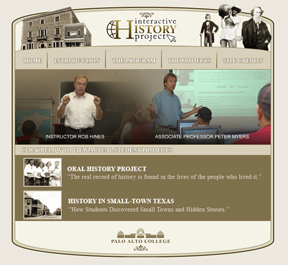
Screen shot of Interactive History Project webpage
Here at Palo Alto College, students are being challenged to take a personal look into the past.
Peter Myers, assistant professor of History, began teaching at PAC in 1988 and started assigning Oral History Projects to his very first students. The assignment at the time was to interview a person of considerable age and collect his or her account of the past.
Myers briefly stopped assigning the oral histories in 1991, explaining that the papers were a lot of work on both sides of the desk.
"It wasn't until my last child was old enough and in school that I decided to start them up again," Myers said. "This was in 2001, when we started putting the projects in html format."
He recalled how the research paper itself was no longer the only challenge to his students, and how designing the web page was pushing them to try something they had never done.
For more than ten years now, students have interviewed people who lived through The Great Depression, World War II, Vietnam and The Cold War, just to name a few, and they have shared their knowledge with people around the globe.
A.J. Gonzalez, a Communications major at Palo Alto College, explained how he took his first history course with a different professor where they mainly did essays, and he prefers the hands-on approach to history taken in Myers' class.
"At the very beginning of the project, I didn't know which topic to choose," Gonzalez said.
Originally, the person Gonzalez had planned to interview had become suddenly ill. Undaunted by this circumstance, Gonzalez found an interview when a conversation with a man at church suddenly turned into an impromptu history lesson.
"He talked to me about his involvement with Civil Rights in the late sixties in San Antonio," said Gonzalez. "He kept telling me that 'Everything I'm telling you is true, it's all true,' and I suddenly realized that right there was going to be my topic."
Gonzalez said working in html was very easy. The template for the web page is so well designed that even a person who isn't computer savvy can make a very professional looking page.
Oliver Stone, former PAC student, remembers coming across the Oral History Projects online and finding himself taken aback.
"A friend of mine was doing an online project about Immigration," Stone said. "I was looking through different student pages when I came across the World War II category. I was hooked."
Stone, a self-proclaimed history buff, said that he found himself reading through the pages with a sense of awe.
"We forget that it [World War II] only happened like seventy years ago," Stone said. "Hearing first-hand accounts like this really puts in all in perspective."
Assistant Professor of History Robert Hines explained his Small Town Projects and how they came to be part of his curriculum.
"Peter Myers had already been doing the Oral History Projects for a long while," Hines said. "I was fascinated with the idea, but I wanted to do something a little different."
According to Hines, the idea came to him while visiting a football game in the town of Somerset. The atmosphere and scenery of the place had piqued his interest, and he imagined sending his students out to research other local areas.
"Once, on the first day of class, this student asked me why I was assigning this project," Hines said. "And when I told them that I was going to teach them how to make a web page, that student quickly gathered her belongings and left class, never to return.
Hines stands firm, however, on the idea that if his students remember anything at all from his class, it will surely be the project and their experience.
The Small Town Project is a web site where students post their research on the small town of their choice. It includes photographs and a transcribed interviews with their sources.
Mariana Garcia, a Psychology major at PAC, explained how the Small Town Projects gave her a different view of history and community.
"I have family that lives out in a small town in South Texas," she said. "These projects gave me a glimpse of a kind of secret history to these places, and how people got along with each other. It paints a picture of the social structures at the time."
Visitors are encouraged to view Myers' students' Oral History Projects and Hines' students' Small Town Projects on the Internet at www.alamo.edu/pac/faculty/InteractiveHistory/